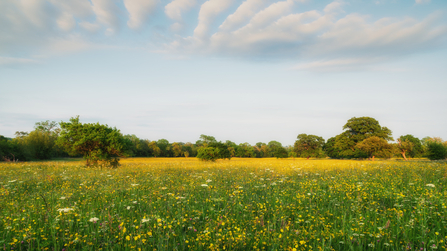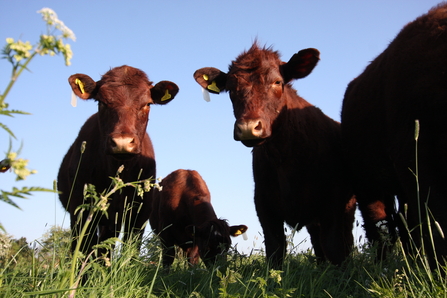
Andy Bartlett

Andy Bartlett
What is a meadow?
A meadow is an area of species-rich grassland, usually enclosed by hedgerows, which is cared for in a particular way. These magnificent habitats are home to beautiful wildflowers and provide a haven for many species of wildlife, from invertebrates, to birds, to small mammals.
Across the county, Nottinghamshire Wildlife Trust cares for several meadows including Ashtons Meadow in Retford, Glebe Field at Attenborough Nature Reserve and meadows at Besthorpe Nature Reserve.
Why are meadows special?
Meadows are host to lots of remarkable species of plants and animals. Even the smallest meadow can boast a high concentration of flora and fauna. They are:
A lifeline for many species - providing space to grow, feed, nest and rest.
Home to some of our most threatened species, such as bumblebees and skylarks.
Pollinator powerhouses – providing pollen and nectar for moths, bees and butterflies.
They’re special too because they are very scarce and fragmented. Around 97% have been lost in the UK since the 1930s due to changes in land use, making this beautiful habitat a rare treat to find.
Often, meadows are ancient and have cultural significance, showing evidence of past farming practices. Ashtons Meadow is an example, where ancient ridge and furrow plough markings can still be seen today. Ashtons Meadow, as well as several other meadow reserves in Nottinghamshire Wildlife Trust’s care, are also designated SSSI sites (meaning they are a site of special scientific interest). This protective status emphasises the range, value and scarcity of the wildlife that thrives within meadow habitats.
All these factors mean that it is essential that remaining meadows are cared for, protected, and restored.
How are meadows cared for?
To sustain an annual life cycle of activity, traditional hay meadows are cut once a year, after which they’re grazed by sheep and cattle. The meadows in Nottinghamshire Wildlife Trust’s care are cut after mid-July.
Although it may seem counterintuitive to cut a meadow, especially when it seems to be at its ecological peak, it is necessary to maintain it. Wildflowers thrive on unimproved soil. The cutting and grazing regime helps to remove excess nutrients from the soil, and also limits the growth of some grass species which if left unchecked would outcompete the wildflowers.
Cutting is done after the plants on the grassland have set their seed, which ensures that the following year there will be new growth. On meadows looked after by Nottinghamshire Wildlife Trust, 10% of the area is left uncut to continue to provide food and shelter for wildlife.
The cut vegetation is left on the ground to dry, being turned periodically to ensure even dryness. This is then baled and stored as hay. After a resting period, livestock are introduced to the meadow to graze. Nottinghamshire Wildlife Trust has a team of grazers including Hebridean sheep and Lincoln Red cattle, who, by treading on the ground and grazing, help to create conditions for wildflowers to thrive. The livestock graze throughout the winter after which the meadow is left to grow again until mid-July and the cycle repeats.

Lincoln Red cattle credit Olivia Masi
Looking after hay meadows in this way has been in practice for centuries. Now, with these habitats in stark decline, it’s more important than ever that we work to protect them and the incredible wildlife they support.